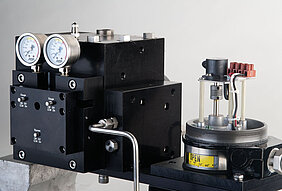Modern automation technology is relying on exact positional data for moving machinery parts. The measurement values are provided by linear and rotary sensors, which must be immune to temperature, vibrations, and other environmental influences. In addition, many applications regularly require fast movement cycles, high-frequency oscillations, and/or continuous mechanical rotation. For this reason, non-contacting processes, which are practically free of wear and tear, have become increasingly prevalent. They are employed in the electro-hydraulic actuators of pipeline ball valves, for instance.
Koso America, for example, utilizes our robust, non-contacting sensor series RSC-2800 for position sensing inside an electro-hydraulic actuator suitable for ball valves of varying nominal width. This application uses the sensor signal to control the precise adjustment of the ball valve within milliseconds.
The electro-hydraulic actuator bascially comprises two main components: the drive itself, consisting of hydraulic cylinder, control circuit, and power module, as well as a control unit. The drive is mounted directly atop the ball valve on the pipeline, while the control unit can be installed remotely. The power module includes an electric motor for the delivery of oil into the dual-action hydraulic cylinder. This cylinder can move in either direction, depending on requirements.
The rotary sensor plays an important role in positioning. It is mounted directly on the slide shaft and provides the current positional real value as a 4 ... 20 mA analog signal to be sent to the control unit. The control unit calculates the difference between real value and target value. If it exceeds a certain value, adjustments are made.
This method is highly economical, as there will be hardly any energy consumption after reaching the target position. In addition, the closed circuit does not require a large oil reservoir, wich also conserves resources.



